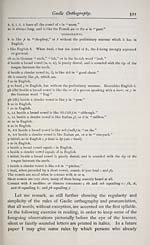Blair Collection > Celtic magazine > Volume 12
(530)
Download files
Complete book:
Individual page:
Thumbnail gallery: Grid view | List view

520 The Celtic Magazine.
"duine," z in "is" (and), o in " rogha," and ?/ in " agus." The
same sound is found in English in "hov^r," "s^me," "f?m."
For the guidance of beginners in reading Gaelic, I propose to
use the ordinary vowel accents, with the addition of ? to represent
the short sound of (! as in "where," while e without any mark
represents the short sound of e in "whey," and <? for the short
sound of (), as in " not," " hot," etc. I shall also use the diaeresis,
thus a, , etc., to represent the vowels when sounded like o in
" some," and small capitals to represent the double sound of / (//)
and n (jiii), thus — L, LL, N, NN. Letters which are silent
or but very faintly sounded I shall put in italics, thus —
" fi/h^ach," " LCii'AaNN" etc. Of course, after a little practice and
some understanding of the language, the necessity for the use of
these diacritics almost entirely ceases, the context in most cases
showing whether the required word is " cas," a foot, or " cas," a
dilemma; "tur,"a tower, or "tur," entirely. The point I wish to
establish is, that so far from requiring a phonetic system of spelling,
— a thing, I fear, out of the question at this time of day, and an
experiment that would seriously endanger the life of our vener-
able linguistic grandmother — our orthography is quite sufficient
for our purposes, and the only cause of stumbling is that our
Saxon friends forget that our vowels and consonants are Gaelic,
not EnglisJi ones.
The following, I believe, will be found pretty complete for
practical purposes. I have omitted one or two sounds that are so
closely related to some of those given below that to give them
distinct diacritics for themselves would but perplex the learner : —
VOWELS.
a as in " father. "
a ,, ,, "lass," or German "Mann."
e ,, ,, " whey."
e ,, ,, the notin " survey."
e ,, ,, "where."
e ,, ,, " whet."
i ,, ,, "machine,"
i ,, ,, "ratify,"
6 ,, ,, "toe."
o ,, ,, " canto."
6 ,, ,, "lord."
6 ,, ,, "hot."
u ,, ,, " pull,"
u „ ,, "put."
"duine," z in "is" (and), o in " rogha," and ?/ in " agus." The
same sound is found in English in "hov^r," "s^me," "f?m."
For the guidance of beginners in reading Gaelic, I propose to
use the ordinary vowel accents, with the addition of ? to represent
the short sound of (! as in "where," while e without any mark
represents the short sound of e in "whey," and <? for the short
sound of (), as in " not," " hot," etc. I shall also use the diaeresis,
thus a, , etc., to represent the vowels when sounded like o in
" some," and small capitals to represent the double sound of / (//)
and n (jiii), thus — L, LL, N, NN. Letters which are silent
or but very faintly sounded I shall put in italics, thus —
" fi/h^ach," " LCii'AaNN" etc. Of course, after a little practice and
some understanding of the language, the necessity for the use of
these diacritics almost entirely ceases, the context in most cases
showing whether the required word is " cas," a foot, or " cas," a
dilemma; "tur,"a tower, or "tur," entirely. The point I wish to
establish is, that so far from requiring a phonetic system of spelling,
— a thing, I fear, out of the question at this time of day, and an
experiment that would seriously endanger the life of our vener-
able linguistic grandmother — our orthography is quite sufficient
for our purposes, and the only cause of stumbling is that our
Saxon friends forget that our vowels and consonants are Gaelic,
not EnglisJi ones.
The following, I believe, will be found pretty complete for
practical purposes. I have omitted one or two sounds that are so
closely related to some of those given below that to give them
distinct diacritics for themselves would but perplex the learner : —
VOWELS.
a as in " father. "
a ,, ,, "lass," or German "Mann."
e ,, ,, " whey."
e ,, ,, the notin " survey."
e ,, ,, "where."
e ,, ,, " whet."
i ,, ,, "machine,"
i ,, ,, "ratify,"
6 ,, ,, "toe."
o ,, ,, " canto."
6 ,, ,, "lord."
6 ,, ,, "hot."
u ,, ,, " pull,"
u „ ,, "put."
Set display mode to: Large image | Transcription
Images and transcriptions on this page, including medium image downloads, may be used under the Creative Commons Attribution 4.0 International Licence unless otherwise stated. ![]()
| Early Gaelic Book Collections > Blair Collection > Celtic magazine > Volume 12 > (530) |
|---|
| Permanent URL | https://digital.nls.uk/76466860 |
|---|
| Description | Volume XII, 1887. |
|---|---|
| Shelfmark | Blair.13 |
| Attribution and copyright: |
|
| Description | A selection of books from a collection of more than 500 titles, mostly on religious and literary topics. Also includes some material dealing with other Celtic languages and societies. Collection created towards the end of the 19th century by Lady Evelyn Stewart Murray. |
|---|
| Description | Selected items from five 'Special and Named Printed Collections'. Includes books in Gaelic and other Celtic languages, works about the Gaels, their languages, literature, culture and history. |
|---|

